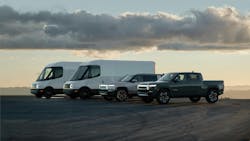Walk onto nearly any automotive or trucking trade show floor and you’ll see at least one, if not several, new electric vehicle startups and the concept or prototype of their vehicle. It’s become a theme at industry trade shows year after year.
While it’s exciting to see what some of the brightest brains in the industry can come up with, it’s hard to know which to take seriously. After all, there’s no way of knowing which of these new brands will actually bring a vehicle to production–or which ones will make it to production and then come to a screeching halt. (We’re looking at you, Lordstown Motors and Fisker.)
FleetOwner affiliate publication IndustryWeek keeps a tab on multiple new EV startups with a Hot or Not list, rating these startups from Hot, OK, Mixed, and Not. The publication ranks these startups on aspects such as “production/delivery goals, financials, major news/deals, and the outlook for its potential to perform better.” IndustryWeek releases a new Hot or Not list each quarter, and it’s interesting to see how quickly the status of these startups can change.
It begs the question: What does it take to go from a startup to an OEM?
How one of the first OEMs came to be
An OEM, or original equipment manufacturer, in the automotive and trucking industry is the company that builds the vehicles–think: Ford, General Motors, Volvo, Peterbilt, etc.
To compare an EV manufacturer to the most recently established internal combustion engine vehicle manufacturer would be unfair. With a refueling infrastructure well established, any newer ICE vehicle manufacturer would have an edge on an EV startup. Instead, perhaps it’s more applicable to compare an EV startup of today with some of the very first vehicle OEMs established at a time when refueling infrastructure was also in its infancy.
While some legacy OEMs have been around for well over a century, even some of the most successful of them don’t have an instant success story.
See also: History of the 7 major heavy-duty truck manufacturers in the U.S.
Before Henry Ford became the legend he’s known as today, he tried and failed with two automobile companies before finding success with Ford Motor Company back in 1903. He first began the Detroit Automobile Company in 1899; the company dissolved in January 1901. In November of that same year, Ford—and members of the recently dissolved Detroit Automobile Company—founded the Henry Ford Company.
Ford left the company just four months later in March 1902 to focus on building a racer. Those in charge at the Henry Ford Company would go on to rebrand as the Cadillac Automobile Company.
By November 1902, Ford partnered with a Detroit coal dealer who funded the development of a lightweight automobile. The partnership established the formation of the Ford and Malcomson Company; however, the business operated as the “Ford Motor Company,” according to the Henry Ford Heritage Association. Later in June 1903, the company was officially renamed as such.
On July 15, 1903, Ford Motor Company sold its first vehicle, the Model A. By the end of September, the company turned a profit, selling 195 vehicles.
Modern OEM development
The world has changed within the last 12 decades. Vehicle ownership for personal commutes is a downright necessity in many parts of the U.S., and it’s a must for many businesses as well.
At least one vehicle is registered to 91.7% of U.S. households, and 22.1% of households have three or more vehicles, according to Forbes’ assessment from the most recent data available from the Census Bureau. The American desire for vehicles is insatiable, and with the widespread introduction of electric vehicles, Americans have even more choices to satisfy their hunger.
EV popularity has grown with consumers and business owners alike. As of Q4 2023, there were more than 3.5 million light-duty EVs registered in the U.S., according to the U.S. Department of Energy. As of 2023, there are about 520,000 heavy-duty EVs registered in the U.S., according to the International Council on Clean Transportation. Earlier this year, FleetOwner covered one of the more successful heavy-duty EV manufacturers, Orange EV, which has contributed to the half million in operation.
This growth happened over a short time. In 2016, there were a total of roughly 280,000 EVs on American roadways compared to 2.4 million in 2022, according to Esri. This growth is, in large part, thanks to Tesla.
While electric cars had been developed in the past by legacy OEMs, such as General Motors and Nissan, it was the introduction of Tesla that gave EVs its most significant bump in popularity. The company has seen its share of ups and downs over the two decades since its founding, but Tesla is considered a dominant player in the EV segment, capturing nearly 80% of the market share in 2020, according to Business Insider, and reporting year-over-year profit increases.
Rivian: EV supplier of e-commerce giant Amazon
While Tesla could be considered the North Star in the EV segment, other players in the market, both startups and legacy OEMs, have stolen market share from Tesla with each year that passes. One of those is Rivian, an EV startup with two consumer vehicles on the market and the manufacturer and primary supplier of Amazon’s electric last-mile delivery vehicles.
Rivian was founded as “Mainstream Motors” in 2009 by RJ Scaringe. It then became “Avera Motors” before the name Rivian was chosen in 2011. Rivian began its foray into the EV segment by first designing a sports car. The project was scrapped in 2011. Three years later in 2015, Rivian acquired enough funding to establish two research facilities: one in California and one in Michigan. In 2017, Rivian bought a manufacturing facility in Normal, Illinois, previously owned by Mitsubishi.
At the end of 2017, Rivian announced the completion of its two prototypes. Within one year, the Rivian R1T and the R1S debuted at the Los Angeles Auto Show, according to Electrek.
Ten years after its founding, Rivian had more than 1,000 employees and facilities in three states and two countries. Yet, it had no vehicle sales. In February 2019, Amazon announced a $700 million investment into Rivian. Later in September, the e-commerce giant announced plans to purchase 100,000 custom-built electric vans from the EV manufacturer. Other investors include Cox Automotive, T. Rowe Price, and recently, Volkswagen with a $5 billion investment.
In November 2023, Rivian announced it no longer had an exclusivity agreement with Amazon concerning its electric vans. This led to a partnership announcement in March 2024 with JB Poindexter and Co., parent company of commercial van body builder, Morgan Olson. This partnership solidified Rivian’s entrance into the commercial van and fleet segment.
While Rivian is making moves in the EV market, it has yet to turn a profit in its 15 years in business. Reuters reported the company is losing nearly $40,000 with each vehicle it delivers to customers, and FleetOwner-affiliate publication Industry Week recently rated the startup an “Okay” on its EV “Hot or Not” list due to its “layoffs, flat revenue, and a high cash burn.”
Whether Rivian will become one of the first legacy EV OEMs–that’s something only time can tell.
About the Author
Jade Brasher
Senior Editor Jade Brasher has covered vocational trucking and fleets since 2018. A graduate of The University of Alabama with a degree in journalism, Jade enjoys telling stories about the people behind the wheel and the intricate processes of the ever-evolving trucking industry.

